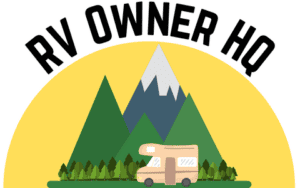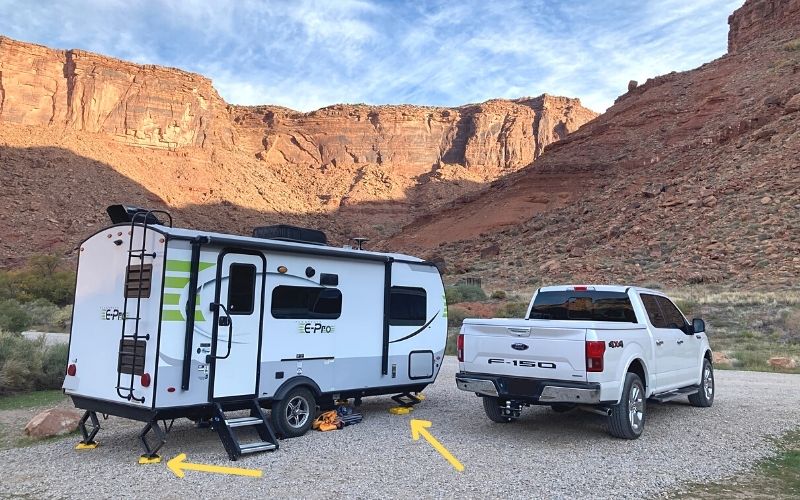There are many steps involved in setting up an RV campsite properly but one of the most important is to get the RV level and stabilized.
As a stable and level RV is the foundation of a good camping experience.
Because if the RV is not level it can cause all sorts of problems from draining grey and black water tanks, to making it harder to open doors and cabinets.
Not to mention it can make it difficult to get a good night’s sleep!
Plus, there’s nothing fun or relaxing about camping in an unstable RV that’s shaking or rocking back and forth.
If you’re new to RVing though, you probably have a few questions about how to properly stabilize and level an RV.
And one of the most common questions, in regards to both is, “What Do You Put Under RV Jacks?”
Because of this, we thought we would write this blog post, to explain the ins and outs of what you put under RV jacks.
What Do You Put Under RV Jacks?
The most popular choices for what to put under RV jacks include jack pads, jack blocks, RV leveling blocks, permanent jack pads, and dimensional lumber.
And which one you should choose depends on your situation as well as your particular needs.
So, let’s take a closer look at each option to help you decide which option is best for you and your RV.
Jack Pads
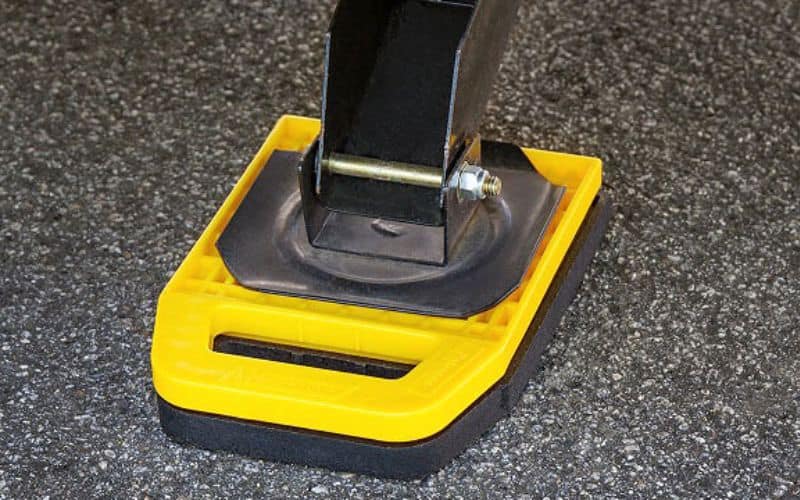
Jack pads, which are usually made from either one-inch thick plastic or rubber are one of the most popular options to place under RV jacks.
As they’re specifically designed to stabilize RV jacks and keep them from sinking into the ground
Jack pads can also be used for either stabilizer jacks or leveling jacks.
And they offer a great deal of support and stability, while also being relatively inexpensive. As jack pads usually only cost between $15 and $20 for a set of two.
To see the most popular jack pads made by Camco on Amazon click here.
Leveling Jack Blocks
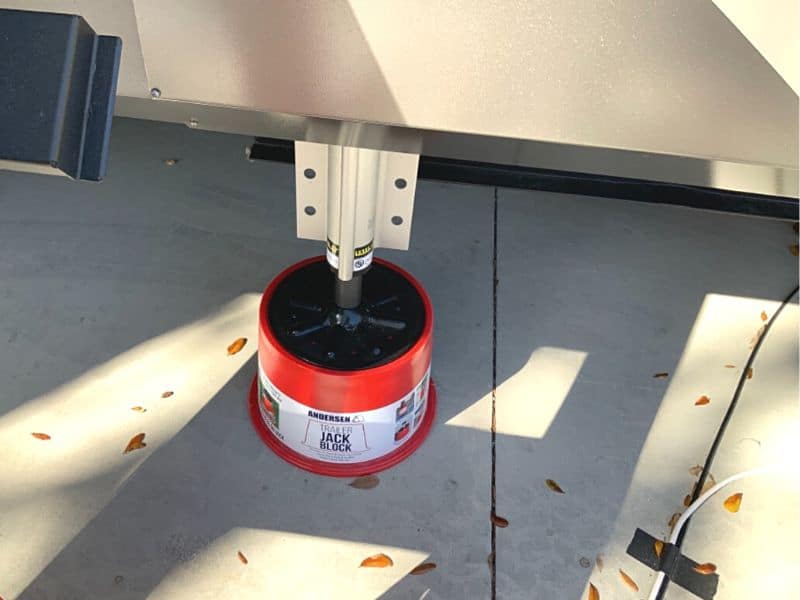
Leveling jack blocks are specifically designed for leveling jacks and allow you to level your RV without needing to extend your leveling jacks as much.
Which can provide a much more solid and stable feel inside the RV and helps to prevent swaying.
As jack blocks are usually anywhere from 6 to 10 inches tall depending on the brand.
Because of this, your RV leveling jacks don’t have to extend all the way to the ground to level the RV, reducing the amount of jack that has to be extended.
Plus like standard jack pads, they help to prevent leveling jacks from sinking into the ground, as they disperse the weight of the jack.
To see the most popular leveling jack blocks on Amazon click here.
RV Leveling Blocks
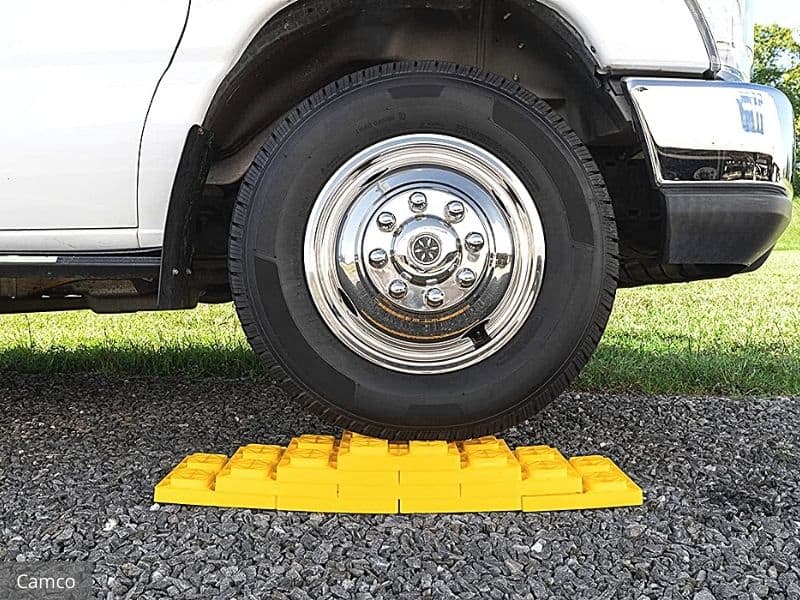
RV leveling blocks, which are typically one inch tall, made from plastic, and look like a short “Lego” block are another popular choice to place under RV jacks.
As they’re able to serve double-duty because while they are most commonly used to manually level an RV, they can also be used as a jack pad as well.
If you don’t feel like buying separate jack pads, like the ones above.
They even make leveling block caps that fit over the leveling block, giving the block a flat surface like a jack pad, to provide a more uniform surface for the jack to rest on.
To see the most popular leveling blocks made by Tri-Lynx on Amazon click here.
Permanent Jack Pads
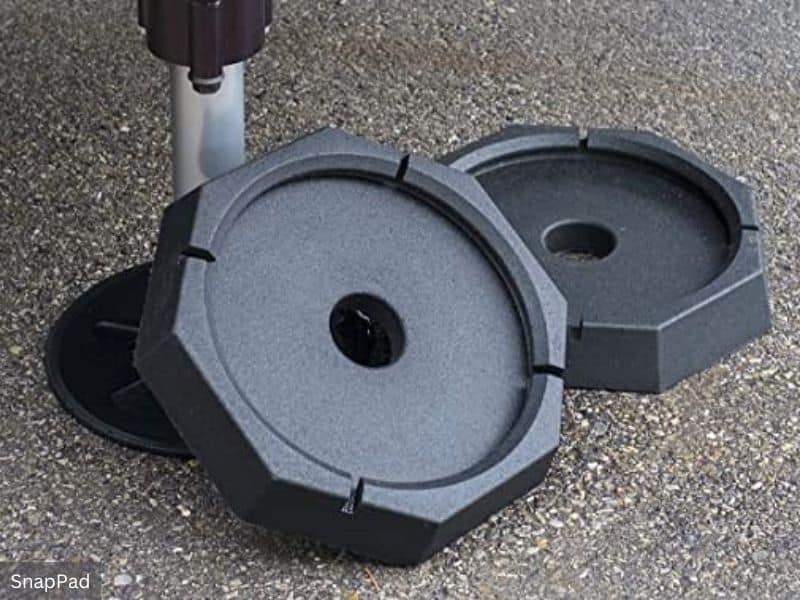
While not as popular as the other above-mentioned options, permanent jack pads, are another option to use under RV leveling jacks.
As permanent jack pads are designed to attach to the bottom of leveling jacks.
To provide a larger footprint for your leveling jacks, so they’re less likely to sink into the ground.
And because they’re made from rubber, they also conform better to uneven terrains like gravel and offer a moderate level of vibration dampening.
But perhaps the best part about installing permanent jack pads on your RV is that it eliminates the need to crawl under the RV to place jack pads.
To see the most popular permanent jack pads made by SnapPad on Amazon click here.
Dimensional Lumber
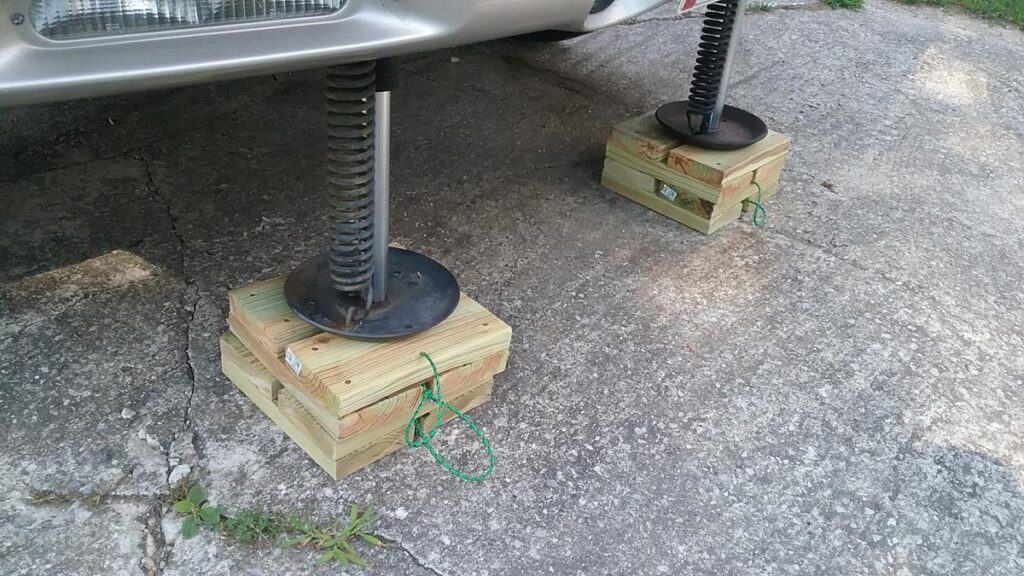
The final option that some RVers choose to use under their RV jacks is dimensional lumber that they make into homemade jack pads.
As dimensional lumber is customizable and tends to be less expensive compared to buying store-bought jack pads.
To be honest though, with the high cost of lumber, I’m not sure how much money you’re really saving.
Unless you happen to have some scrap lumber laying around.
Are Jack Pads Necessary for RVs?
Unlike leveling blocks, you could theoretically not use jack pads and just rest your RV jacks directly on the ground.
However, there are a handful of reasons why it’s always best practice to use jack pads whenever you’re deploying your RV jacks, which we’ve listed below.
Improves Stability and Leveling
The main reason why it’s important to use jack pads under RV jacks is that it provides a solid level surface for your RV jacks to rest on.
Which helps ensure that your RV remains stable and level, while also reducing bouncing, rocking, and shaking.
Protects RV Jacks and Jack Feet
Another reason to use jack pads is that it helps protect the feet on your RV jacks from getting damaged or bent out of shape.
By providing a softer surface for them to rest on instead of concrete, asphalt, or rocky terrain.
Additionally, if you’re parking your RV on grass or soft earth, using jack pads also helps to prevent your RV jacks from sinking into the ground and making direct contact with the ground as well as moisture.
Which in turn helps to prolong the life of your RV jack feet.
Reduces Vibration and Noise
Deploying RV jacks without jack pads can be quite loud, due to the metal jacks making direct contact with the hard ground.
In addition, without jack pads, vibrations are much more likely to travel through the RV.
Which can be quite annoying, especially if you’re trying to sleep.
So, by using jack pads you can help to reduce both the noise and vibration created by your RV jacks, making for a much more pleasant camping experience.
Prevents Damage to the Campsite
Last but not least, another good reason to use jack pads is that it helps to prevent damage to the campsite.
As RV jacks can easily sink into soft ground, such as dirt or sand leaving behind holes.
Which can be especially damaging in more delicate environments.
Such as a sandy beach, or anywhere that has a sensitive ecosystem that could be easily disrupted.
But even if you’re not parked on dirt or sand, you can still damage hard surfaces, such as asphalt or concrete, with RV jacks.
Especially with heavier RVs, such as Class A RVs, Class C RVs, or fifth wheels.
Whose jacks can often dig into or cave in hard surfaces, when jack pads are not used to help disperse the weight.
Leaving behind depressions and even holes.
Because of this, many RV parks actually require the use of jack pads, to prevent damage to their campsites.
Why Does My Camper Shake When I Walk In It?
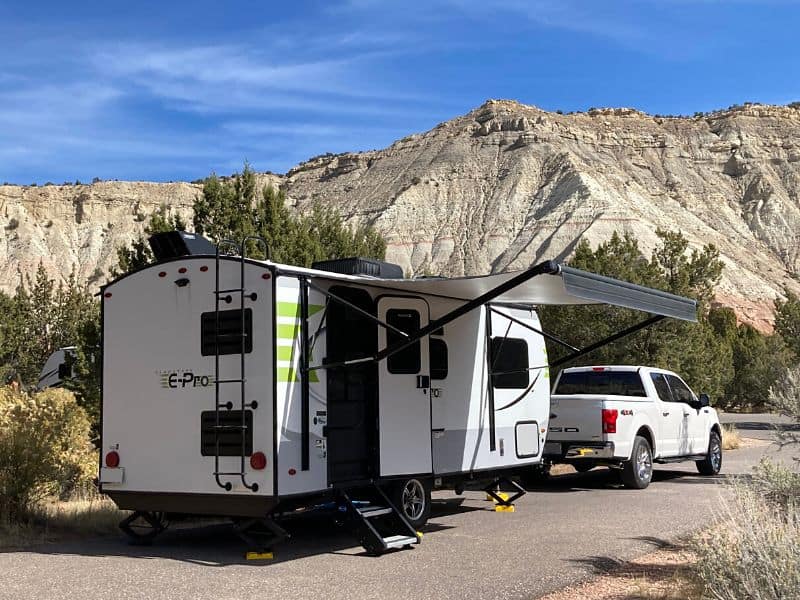
If your RV stabilizer jacks and or RV leveling jacks are deployed and your camper is shaking or bouncing when you walk in it, this can be caused by several issues, which we’ve listed below.
Loose or Damaged Stabilizer Jacks/Leveling Jacks
If your RV has loose or damaged stabilizer jacks or leveling jacks, this could be the reason why your RV is shaking when you walk in it.
As loose or damaged stabilizer jacks or leveling jacks will limit the amount of support they’re able to offer.
Which in turn can cause the RV to shake or wobble.
Additionally, if your stabilizer or leveling jacks are damaged, they may not be able to properly support the weight of the RV.
Which can also lead to shaking and instability.
Improper Leveling on Uneven Terrain
Another reason why your RV might shake is if the terrain you’re parked on is uneven and you haven’t properly leveled the RV.
Because being just slightly out of level can lead to shaking inside the RV.
Worn Out Chassis or Suspension Parts
Another reason RVs shake when you walk in them is worn out chassis or suspension parts.
Especially on older RVs that are 10 years or older.
Because while stabilizer jacks will help to stabilize an RV, if you have worn chassis or suspension parts, which act as the foundation of an RV, you can still experience some level of shaking or instability.
So if you’ve checked for and eliminated the first two issues and your RV is still shaking or wobbling.
Then it’s probably time to have the chassis and suspension inspected, to see if there are any loose or worn parts that might be causing the problem.
How Do You Stop an RV from Shaking or Rocking When Parked?
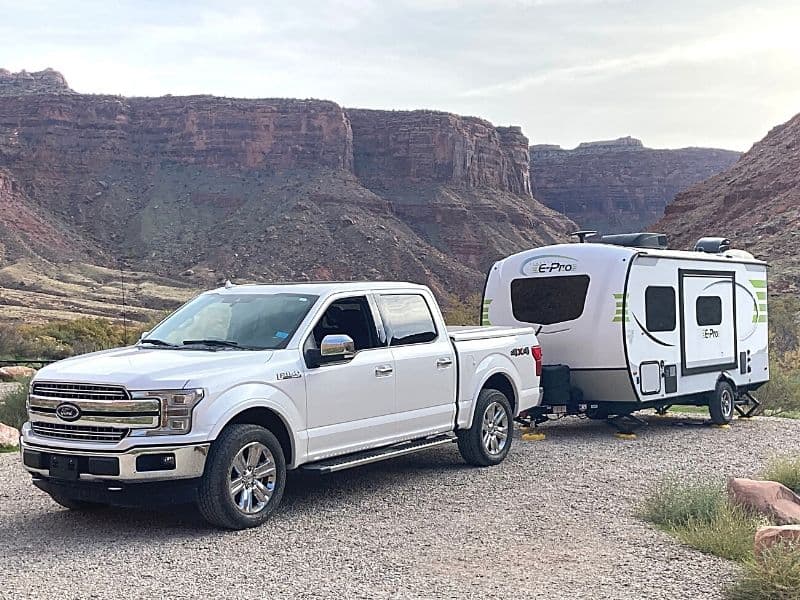
If your RV is shaking or rocking when parked and everything is in good working order, there are a few things you can do to help stabilize the RV.
Which we’ve listed below.
Make Sure the Wheels are Tightly Chocked
The first thing you’ll want to do is make sure the wheels are tightly chocked.
As even slightly loose wheel chocks can cause an RV to rock when parked, particularly if the ground is uneven or unlevel.
Check to Ensure the RV is Level
The next thing you’ll want to do is check to make sure the RV is completely level.
As an RV that is even slightly unlevel can cause it to be unstable, which can lead to rocking or unwanted movement.
Deploy RV Stabilizer Jacks
One of the quickest and easiest ways to stop an RV from rocking when parked is to simply deploy your RV’s stabilizer jacks.
As stabilizer jacks are specifically designed to help stabilize an RV and prevent shaking and or rocking.
Use Jack Pads
The last thing you can do to help reduce rocking in an RV is to use jack pads under your RV’s stabilizer or leveling jacks.
As jack pads provide a more level and stable surface for your RV jacks to rest on.
Which in turn will make the RV itself more stable, and help to prevent things like shaking, bouncing, and rocking.
What Do You Put Under a Tongue Jack on a Travel Trailer?
The same jack pads, leveling blocks, or dimensional lumber used for other RV jacks, can also be used under travel trailer tongue jacks as well.
As tongue jacks on travel trailers do not require any type of special jack pad for leveling.
Due to the fact, that travel trailer tongue jacks operate the same as any other jack on an RV, in that, all they really need to operate properly is a solid level surface to rest on.
How Do You Use an RV Jack Pad?
RV jack pads are typically used for one of two reasons or for both.
The first way is to use them as a leveling pad, which is accomplished by placing the RV jack pads under the RV’s stabilizer or leveling jacks, in order to provide a more level surface for the jacks to rest on.
Which in turn, will help to stabilize the RV and prevent it from shaking or bouncing.
The second way is to use them as a support pad, which is accomplished by placing the RV jack pads under the RV’s stabilizer or leveling jacks, in order to provide additional support for the jacks.
Which is particularly useful when stabilizing or leveling an RV on soft ground, such as sand or dirt.
As the RV jack pad will help to distribute the weight of the RV more evenly and prevent the jacks from sinking into the ground.
Can You Level an RV with Stabilizer Jacks?
Stabilizer jacks should never be used to level an RV, as they’re only designed for stabilization.
Attempting to use stabilizer jacks for leveling will almost certainly damage them.
Due in large part to their design and construction.
As stabilizer jacks, which are typically configured like scissor jacks and located at the front and rear, are not strong enough to support the weight of an RV for leveling.
So while stabilizer jacks can help to prevent an RV from rocking and shaking when parked.
They should never be used for leveling an RV, as doing so will quickly damage them.
How Do You Make a Jack Pad?
While you can certainly buy store-bought jack pads from companies like Camco and Tri-Lynx.
You can also make your own heavy-duty jack pads quite easily with just a few supplies and some basic DIY skills.
RV Jack Pad Material List
To make your own RV jack pads, you’ll need the following supplies:
- 3/4-Inch Thick Plywood (Preferably Treated)
- 2×4 or 4×4 Depending on the Desired End Height (Preferably Treated)
- 2 1/2-Inch Exterior Wood Screws
- Large Exterior Metal Handel
- Wood Glue
- Drill
- Drill Bit Set
- Circular Saw
- Tape Measure
- Pencil
- Chop Saw (Nice to Have for Straighter Cuts)
- Level and Square (Nice to Have for Straighter Lines)
Heavy-Duty RV Jack Pad Build Instructions
Now that we have all the materials and supplies we need, it’s time to start building the jack pad.
- Step 1: Cut a 2×4 or 4×4 into four equal pieces 14″ long.
- Step 2: Cut out two pieces of 3/4 plywood 14″ by 14″.
- Step 3: Dry fit all the wood together by sandwiching the four pieces of dimensional lumber between the two pieces of plywood.
- Step 4: Remove the top piece of plywood from the dry fit.
- Step 5: Apply a liberal amount of wood glue to the top of the dimensional lumber that the top piece of plywood was resting on.
- Step 6: Place the top piece of plywood back onto the dimensional lumber that now has glue on it and make sure it’s properly aligned on all sides.
- Step 7: Use 2 1/2-inch exterior screws to screw the top piece of plywood onto the dimensional lumber below, drilling three screws into each piece of wood, evenly spacing, and slightly countersinking each screw.
- Step 8: Flip the jack pad over and repeat steps 5 through 7 for the bottom piece of plywood.
- Step 9: Install an exterior handle on one side of the jack pad.
Final Thoughts
Now that you know what to put under RV jacks, as well as how to make your own heavy-duty jack pads.
You can choose the best option for your needs to help ensure your RV is stable, secure, and level.
Because after all, as we stated at the start of this blog post, a stable and level RV is the foundation of a good camping experience.
Recent Posts
When cruising down the highway in your RV, the last thing you want is a tire blowout! Not only is it dangerous, but RV tire replacement isn't cheap, costing $200 to $300 per tire. The good news,...
Nothing ruins an RV adventure faster than a breakdown with no way to fix it. Because of this, every RVer should have a well-stocked RV tool kit for those unexpected roadside emergencies and campsite...
